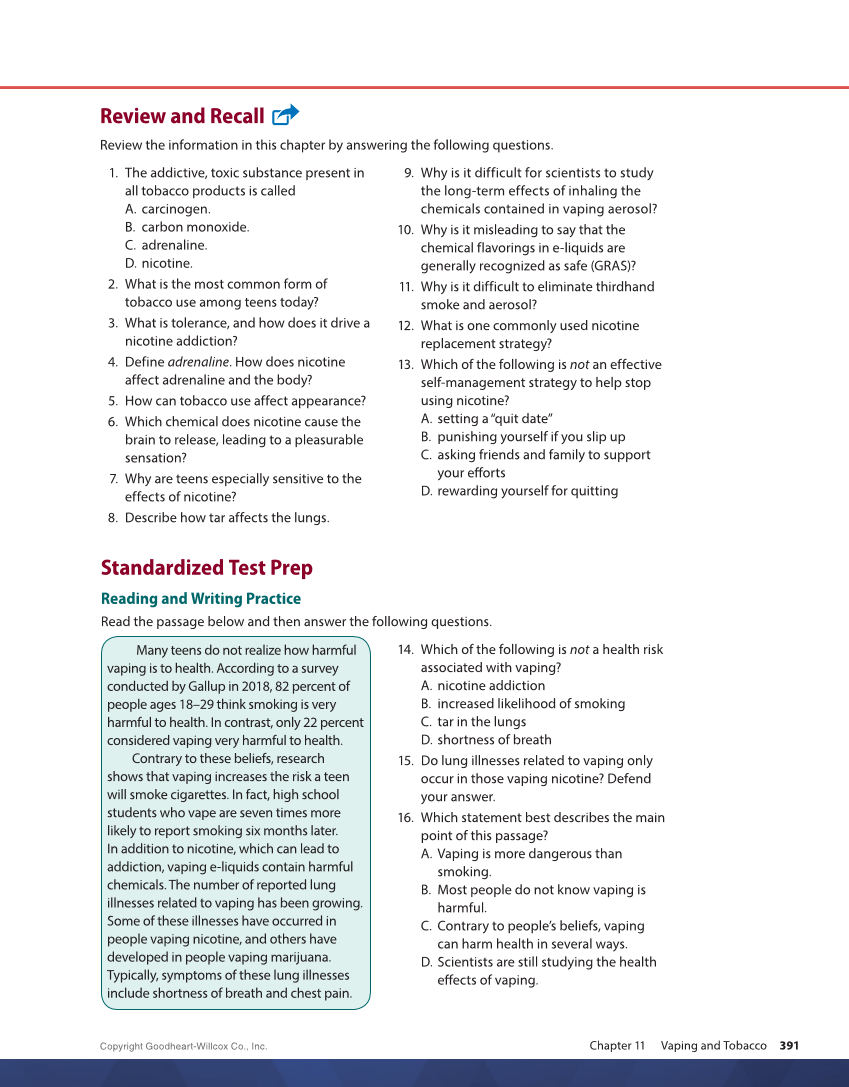Review and Recall Review the information in this chapter by answering the following questions. 9. Why is it difficult for scientists to study the long-term effects of inhaling the chemicals contained in vaping aerosol? 10. Why is it misleading to say that the chemical flavorings in e-liquids are generally recognized as safe (GRAS)? 11. Why is it difficult to eliminate thirdhand smoke and aerosol? 12. What is one commonly used nicotine replacement strategy? 13. Which of the following is not an effective self-management strategy to help stop using nicotine? A. setting a “quit date” B. punishing yourself if you slip up C. asking friends and family to support your efforts D. rewarding yourself for quitting 1. The addictive, toxic substance present in all tobacco products is called A. carcinogen. B. carbon monoxide. C. adrenaline. D. nicotine. 2. What is the most common form of tobacco use among teens today? 3. What is tolerance, and how does it drive a nicotine addiction? 4. Define adrenaline. How does nicotine affect adrenaline and the body? 5. How can tobacco use affect appearance? 6. Which chemical does nicotine cause the brain to release, leading to a pleasurable sensation? 7. Why are teens especially sensitive to the effects of nicotine? 8. Describe how tar affects the lungs. Standardized Test Prep Reading and Writing Practice Read the passage below and then answer the following questions. Many teens do not realize how harmful vaping is to health. According to a survey conducted by Gallup in 2018, 82 percent of people ages 18–29 think smoking is very harmful to health. In contrast, only 22 percent considered vaping very harmful to health. Contrary to these beliefs, research shows that vaping increases the risk a teen will smoke cigarettes. In fact, high school students who vape are seven times more likely to report smoking six months later. In addition to nicotine, which can lead to addiction, vaping e-liquids contain harmful chemicals. The number of reported lung illnesses related to vaping has been growing. Some of these illnesses have occurred in people vaping nicotine, and others have developed in people vaping marijuana. Typically, symptoms of these lung illnesses include shortness of breath and chest pain. 14. Which of the following is not a health risk associated with vaping? A. nicotine addiction B. increased likelihood of smoking C. tar in the lungs D. shortness of breath 15. Do lung illnesses related to vaping only occur in those vaping nicotine? Defend your answer. 16. Which statement best describes the main point of this passage? A. Vaping is more dangerous than smoking. B. Most people do not know vaping is harmful. C. Contrary to people’s beliefs, vaping can harm health in several ways. D. Scientists are still studying the health effects of vaping. Copyright Goodheart-Willcox Co., Inc. Chapter 11 Vaping and Tobacco 391
